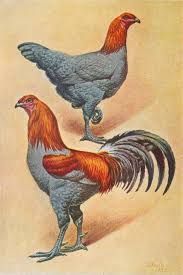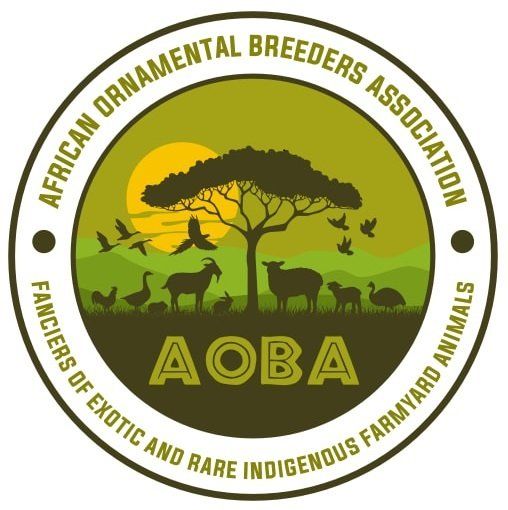
The Bruges Fighter
Breed History
Origin
Gamefowl have been bred for centuries in West Flanders and Northern France for cockfighting. In 1858, 'La race de Bruges' and 'La race de Combat du Nord' were mentioned for the first time. However, the Northern French fighter is a different breed than the Bruges fighter. Further research must show whether this was also the case 150 years ago. The first standard is said to date from 1908. In the past, many of these animals were found, but since the ban on cockfighting in Belgium, the Bruges has become an ornamental breed and is very popular sharply reduced in number. In the past, people have tried - for chauvinistic reasons - to recognize the Bruges, the Tienen and the Liège fighter together as one breed: the 'Belgian fighter'. Fortunately, these three fighter breeds have now been separately recognized again. Yet they, and especially the Bruges ones, suffered greatly from the fact that there was a lot of cross-breeding. Nowadays the Bruges has become a rare sight and survives thanks to a few steadfast lovers. However, a new danger looms: exhibition breeding has tinkered with the standard. AOBA shares the opinion of the Belgian Living Heritage Support Center (SLE), which is of the opinion that too little account was taken of the history of the breed and its useful properties. The Belgian Living Heritage Support Center (SLE) therefore asks to ensure that the flesh color remains pale, which benefits the usefulness - and therefore the attractiveness.
Breed Standard
After years of deliberation, AOBA has decided to establish a revised breed standard for the Bruges fighter (Brugse vechter). AOBA is convinced that this is necessary to provide clarification for its international members and breeders on the African continent. The breed standard is not new, and is entirely based on literature from Flanders in Belgium. This will be strictly interpreted by the AOBA judges and member breeders. This will take effect on April 5, 2024. And this will be promoted internationally as the "AOBA 2024 revised Bruges Fighter breed standard" or "AOBA 2024 BV Standard". The intention is primarily to breed the Bruges Fighter back to the old breed standard.
General appearance
Very large and heavy pea-combed gamefowl with an almost horizontal body position. The typical dark pigmentation of the face and head decorations give the head a very brutal and provocative expression. Despite the rather sparse body feathering, the decorative feathering of the rooster is well developed. Challenging and fearless in character. The fighter from Bruges has a large figure that radiates strength. He used to be a formidable one opponent in the arena. The variety grows very slowly. Bruges fighters take eighteen months to fully develop.
Characteristics
- slow growing breed that only reaches maturity at 18 months but has excellent meat quality
- the hens lay quite well and the cream colored eggs weigh about 65g
- they are not ideal as brooders
- some strains in Belgium are still very combative (although only the Congolese lines are game tested)
Appearance rooster
- comb: not too large pea comb with narrow base, color depending on the
color variety
- head: very powerful with a large and wide flat skull and strongly protruding eyebrows
- face: unfeathered. fine in weave, color depending on the color variety
- beak: powerful and curved, color depending on the color variety
- wattles: rudimentary, preferably missing
- earlobes: very small, color depends on the color variety
- eyes: placed high in the skull, deep-set by the crossing
eyebrows, with dark eye rim, lively, bold and challenging in expression, color depending on the color
- neck: long and powerful, slightly arched
- trunk: rectangular, powerful and fairly elongated. Posture, little raised with a horizontal to slightly sloping backline
- back: very broad, flat, slightly sloping to horizontal, broad loins. Shoulders very broad and well filled
- chest: broad and quite deep but not protruding, powerfully muscled, sternum very long and deep-lying
- wings: strong and well drawn, quite high and almost horizontal
to behave. Wing bows not extended
- tail: well filled and only slightly opened, medium length, angled
carried at a temperature of 20 degrees. The numerous medium-length sickles are slightly curved
- lower thighs: strongly muscled, well defined plumage
- walking legs: medium length, thick, powerful, sufficiently spaced and parallel. Equipped with sturdy and well-developed spurs. Slate blue to dark blue depending on the color variety, darker in young animals
- toes: long, strong and well spread, also the hind toe long and the ground
hitting well. Same color as the walking legs
- nails: well curved, color depends on the color
- feathering: closed, hard and quite tight with little down development. The ornamental feathering, on the other hand, is well developed
- hackle: well developed, fairly long but not too full, reaching up to
the shoulders and the back
- saddle hackle: well developed, well filling transition to the tail
-
skin: bluish skin tolerated
Appearance hen
Except for the secondary sex differences, the same characteristics as in the rooster, with the exception of:
- head decorations: darker than on the rooster
- torso: slightly more rectangular and deeper than the rooster
- back: wide and flat, slightly sloping to horizontal, slightly longer than the width at the shoulders
- tail: fairly closed, carried at an angle of 15 degrees. Tail control feathers fairly long and covering each other well
- walking legs: the presence of spurs in the hen should be considered a quality
Remark
According to the Belgian Living Heritage Support Center (SLE), Bruges fighters are primarily type animals. The color and markings of the plumage have less weight in their assessment.
Yet the color white is not recognized by AOBA.
Recognized color varieties [17): blue black, blue, black gold-necked, gold-necked, black silver-necked, blue silver-necked, golden birch, blue-gold birch, birch, blue birch, partridge, blue partridge, silver partridge, blue-silver partridge, red-shouldered silver partridge, red-shouldered blue-silver partridge an Splash
1. Black
- walking legs and toes: dark blue
- beak and nails: dark horn coloured
- eyes: dark brown to black
- head decorations: purple-red on the cock; black in the hen
Attention! Fibromelanosis not recognized by AOBA (AOBA Breeding Ban).
Since the breed standard of 2012, blue skin has been tolerated. It will be shocking to hear that this is not new. The first breed standard of 1909 already mentions white, sometimes bluish meat. Until 2012, all animals that did not have white skin were systematically expanded at exhibitions. After 2012, however, people veered in the other direction. Openens allowed men to do anything that was not black skin. That was not the intention... Animals with darkly pigmented heads can have a light blue appearance on the skin. There's nothing wrong with that. What is wrong are animals whose connective tissue, bones, skin, etc. are colored (almost) black. There is a different type of pigment behind this, namely the pigmentation that we also recorded in the silkie and the ayam cemani. That kind of dark and black skin is accompanied by black soles of the feet, a black cloaca, etc. We absolutely must remove these animals from our lines. Animals with pale skin with a light blue appearance under the armpits are perfectly in accordance with the current breed standard and with the 1909 breed standard.
Joost De Meyer
Color variety not recognized by AOBA (AOBA Breeding Ban).
2. White
White plumage with:
- walking legs and toes: slate blue
- beak and nails: bluish horn colored
- eyes: dark brown
- head ornaments: dark red to purple red
3. Blue
Blue plumage with:
- walking legs and toes: dark blue
- beak and nails: dark horn coloured
- eyes: very dark brown
- head decorations: purple-red on the cock; black in the hen
4. Black golden neck
Black golden-necked plumage with:
- walking legs and toes: dark blue
- beak and nails: dark horn coloured
- eyes: very dark brown
- head decorations: purple-red on the cock; black in the hen
5. Blue golden neck
Blue golden-necked plumage with:
- walking legs and toes: dark blue
- beak and nails: dark horn coloured
- eyes: very dark brown
- head decorations: purple-red on the cock; black in the hen
6. Black silver-necked
Black silver-necked plumage with:
- walking legs and toes: dark blue
- beak and nails: dark horn coloured
- eyes: very dark brown
- head decorations: purple-red on the cock; black in the hen
7. Blue silver-necked
Blue silver-necked plumage with:
- walking legs and toes: dark blue
- beak and nails: dark horn coloured
- eyes: very dark brown
- head decorations: purple-red on the cock; black in the hen
8. Golden birch
Golden birch plumage with:
- walking legs and toes: dark blue
- beak and nails: dark horn coloured
- eyes: very dark brown
- head decorations: purple-red on the cock; black in the hen
9. Bluegold birches
Blue-golden birch plumage with:
- walking legs and toes: dark blue
- beak and nails: dark horn coloured
- eyes: very dark brown
- head decorations: purple-red on the cock; black in the hen
10. Birch
Birch plumage with:
- walking legs and toes: dark blue
- beak and nails: dark horn coloured
- eyes: very dark brown
- head decorations: purple-red on the cock; black in the hen
11. Blue birches
Blue birch plumage with:
- walking legs and toes: dark blue
- beak and nails: dark horn coloured
- eyes: very dark brown
- head decorations: purple-red on the cock; black in the hen
12. Partridge
Partridge plumage with:
- walking legs and toes: slate blue
- beak and nails: horn coloured
- eyes: orange-red
- head decorations: dark red
13. Blue Partridge
Blue partridge plumage with:
- walking legs and toes: slate blue
- beak and nails: horn coloured
- eyes: orange-red
- head decorations: dark red
14. Silver Partridge
Silver partridge plumage with:
- walking legs and toes: slate blue
- beak and nails: horn coloured
- eyes: reddish brown
- head decorations: dark red
15. Blue-silver partridge
Blue-silver partridge plumage with:
- walking legs and toes: slate blue
- beak and nails: horn coloured
- eyes: reddish brown
- head decorations: dark red
16. Red-shouldered silver partridge
Red-shouldered silver partridge plumage with:
- walking legs and toes: slate blue
- beak and nails: horn coloured
- eyes: reddish brown
- head decorations: dark red
17. Red-shouldered blue-silver partridge
Red-shouldered blue-silver partridge plumage with:
- walking legs and toes: slate blue
- beak and nails: horn coloured
- eyes: reddish brown
- head decorations: dark red
18. Splash
Splash (Dirty white) plumage with:
- walking legs and toes: dark blue
- beak and nails: dark horn coloured
- eyes: very dark brown
- head decorations: purple-red on the cock; black in the hen
Weights:
Young cockerel 4.00 kg Over-year-old or old cockerel +5.00 kg
Young hen 3.50 kg. Adult or old hen 4.00 kg
Mistakes to avoid:
Too little muscular chest; shoulders too narrow; strongly sloping back; wings carried too low; leg position too high; too light leg work; leg position too narrow; eye or beak color too light; leg color too light; white in the earlobes; too little pigment in the face; black skin.
Major mistakes:
Much too small stature; traces of yellow pigment in the beak, legs or skin; yellow or pearly white eyes; white earlobes; absence of dark pigment in the face in the dark color varieties.

